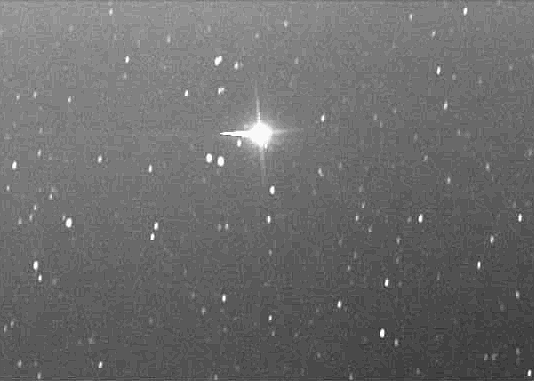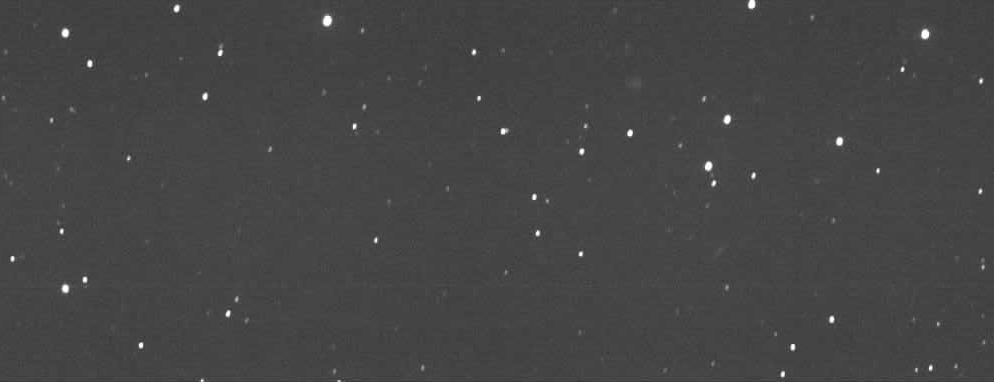
DriftScanning
Warning, this page loads slow!
Technical Information below images is available.
Inspired by Jim Roe , here are the very first drift scan images from Everstar observatory. These images were produced using a program called Scan, written by Christoph Flohr.
This program allows a user to image the sky with a fixed telescope and no tracking. Christopher has made a complex science fairly easy. We simply mounted the camera on our 16" Dobsonian. Note that this is the first time we ever used our camera with this scope and our first solo experience with CCD all together.
Once the camera is mounted you simply focus some stars using CCDOps. We had to put our 2" adapter on, so that the camera could get close enough to the tube to focus. Once we had pinpoint stars (well, as close as our focuser would allow us to) we started taking 5 seconds shots to watch the direction of the star trails. You want these trails moving perfectly vertical and from bottom to top.
Once you achieve this, you double check your focus, double check your trails and understand what your DEC roughly is in relation to where you are pointing in the sky.
Exit CCDOps and boot to DOS (very important that you do not run Scan in a DOS window, but actually from DOS itself). Run Scan and set your dec, focal length, aperture etc. as instructed. Return to the main menu and run Option 4 DriftScan.
The next part might be confusing, as it it will ask you how many lines you want to scan. We tried about 50 or so, but quickly learned that a minimum of 1000 was a good idea.
After seeing that the stars were recording properly, we went for a 10000 line scan, and then a 20000 line scan. These lasted about 10 and 20 minutes respectively, resulting in about 15 and 30MB of data respectively.
I then loaded these images up in CCDOps and saved them out as .gif and pulled them into a paint program. The 20000 line image was clearly superior to the others and the clips you see below came from that scan.
We still need to work on focus and probably could have been a little more vertical.
We went through all this learning and setup in about 5 hours, including about 2.5 hours of imaging time.
The images were shot from our driveway, where there is a streetlight about 35 feet away, and with a full moon. They show a patch of sky near Altair and M71 at about 18.3 Dec using a 16" F4.5 Meade Starfinder with a focal length of 1828 at about 3:20am CST on August 29th.
In future attempts we will try binnning to acquire a Messier object--the image below is slightly less than one Arc Second per Pixel.
We will keep you posted on our next DriftScan experience.
| ||
| ||
| ||
| ||
| ||
|


Drift Scan from Everstar Observatoy in Mobil mode September 4th 12:15 AM @ Powell Observatory
Image taken by Mark Abraham and David Hudgins using a Meade 16" Starfinder Dob and ST7e CCD Camera and CTX Notebook Computer.

Drift Scan from Everstar Observatoy September 6th 2:15 AM off the driveway near a street lamp Image taken by Mark Abraham using a Meade 16" Starfinder Dob and ST7e CCD Camera and CTX Notebook Computer.
This slice comes from Pleiades and is part of a 20000 line scan. Focus was exceptional! (Sometimes you get lucky, this is almost pure luck!) Checkout the entire scan, it's pretty nice!

Drift Scan from Everstar Observatoy September 6th 12:19 AM off the driveway near a street lamp Image taken by Mark Abraham using a Meade 16" Starfinder Dob and ST7e CCD Camera and CTX Notebook Computer.
This slice was taken in Pegasus near Markab. This was a 30000 line scan and dumped a 45MB file. (If you have enough RAM CCDOps will load them) Focus wasn't perfect. This stuff is really touchy!
Information on Driftscanning (in response to a question on MPML
The program I used now has an autoslice feature in it that slices and saves the scans as you go. There are many considerations when Driftscanning, at least in my limited experience.
Someone mentioned timing slices to sync with each other and in my experience, this depends on the approach. For asteroid work you would think that you would want the auto slice feature above enabled, however if you do that, then timing becomes more of an issue as your slices won't line up when you go to blink them, and depending on the size of them, you may waste parts of your images by different parts of space being in different images.
We did some very long scans any where from 2.5 to 5 full degrees and then were able to take the two huge slices, align them in CCDSoft and then scroll through them blinking. If we found unknown asteroids, this enabled us to only slice the pieces we needed to do the astrometrics.
There are some custom programs out there, not freely available that will slice after the fact, thus allowing you to align them, save them and the auto slice after the fact. This too is a nice way to go however in the long run, blinking the whole scan really seems to be a lot faster.
The down side of processing the whole scan as described above is that it takes a PC with a goodly amount of RAM to handle the images.
Finally, in speaking to alignment, The way we devised our approach to this was to align the scope on a bright star, take some snaps of the image to get it positioned perfectly. Then we would power off the scope and wait about 1 minute prior to starting the scan to allow the bright star to drift off the chip, if you do not it will saturate your pixel wells and degrade the whole quality of the scan.
This procedure of power off and waiting has other benefits in terms of making sure the scans align better. This approach allowed to be within one arc minute either side horizontally (Thus reducing loss) and less than 1/2 arc minute in terms of start positions.
The last thing I can contribute to the conversation is that on the longer scans you may begin to see slippage, I.E. the gap between strips increase as the longer the scan the less accurate the tracking gets.
In our case a 5 degree scan, about 20 to 30 minutes seemed to be the upper practical limit.
Talk about data processing when you are done, if I recall correctly once when I sliced them all up, about 1 hour of scanning produced about 80 sets of images, which would likely take me an entire night the traditional way.
Other thoughts, Magnitude will be limited, but on a 30" we believe we were hitting about 21'st Mag with an ST7 (No e). Since the programs match your focal length to your pixel array and the earth's rotation, your total stacked exposure time will be limited, in our case that was about 51 seconds. This will vary from the different setups so it's easy to see where larger scopes will be more suitable for asteroid work due to the limited exposure time. There may be other programs that are able to circumvent this limit.
Once my Large scope comes I plan on attempting this again. I will be interested to see how some of you fair out there with the ST8e as that is what I likely will upgrade to when the time comes.
[Everstar] [Ole EverStaR] [Tech Info] [Astro Links] [Gallery] [News] |
[Everstar] [Staff] [Gallery] [Astro Links] [ESO Info] [Tech Info] |
EverStaR. Copyright KC Resources

